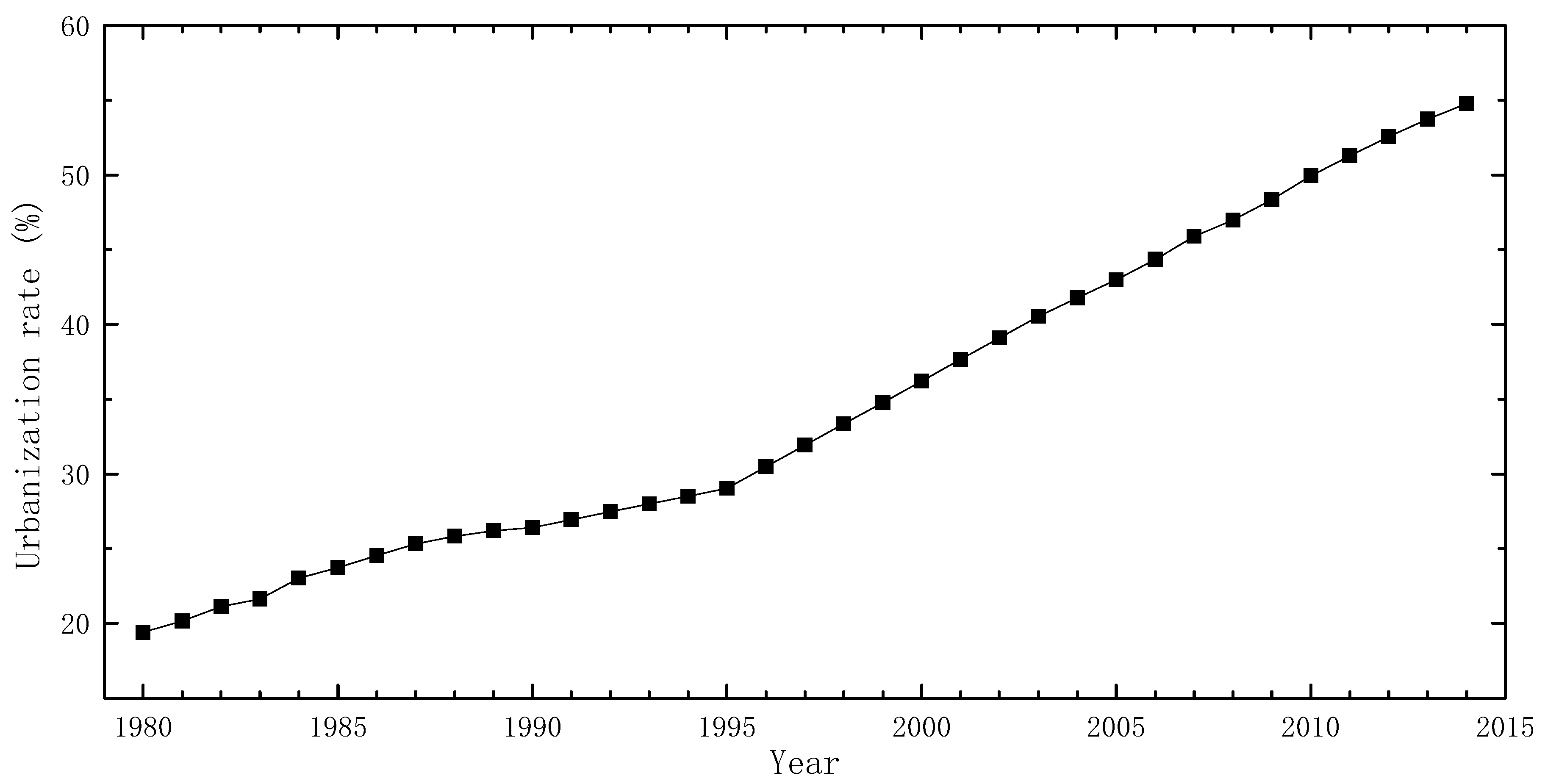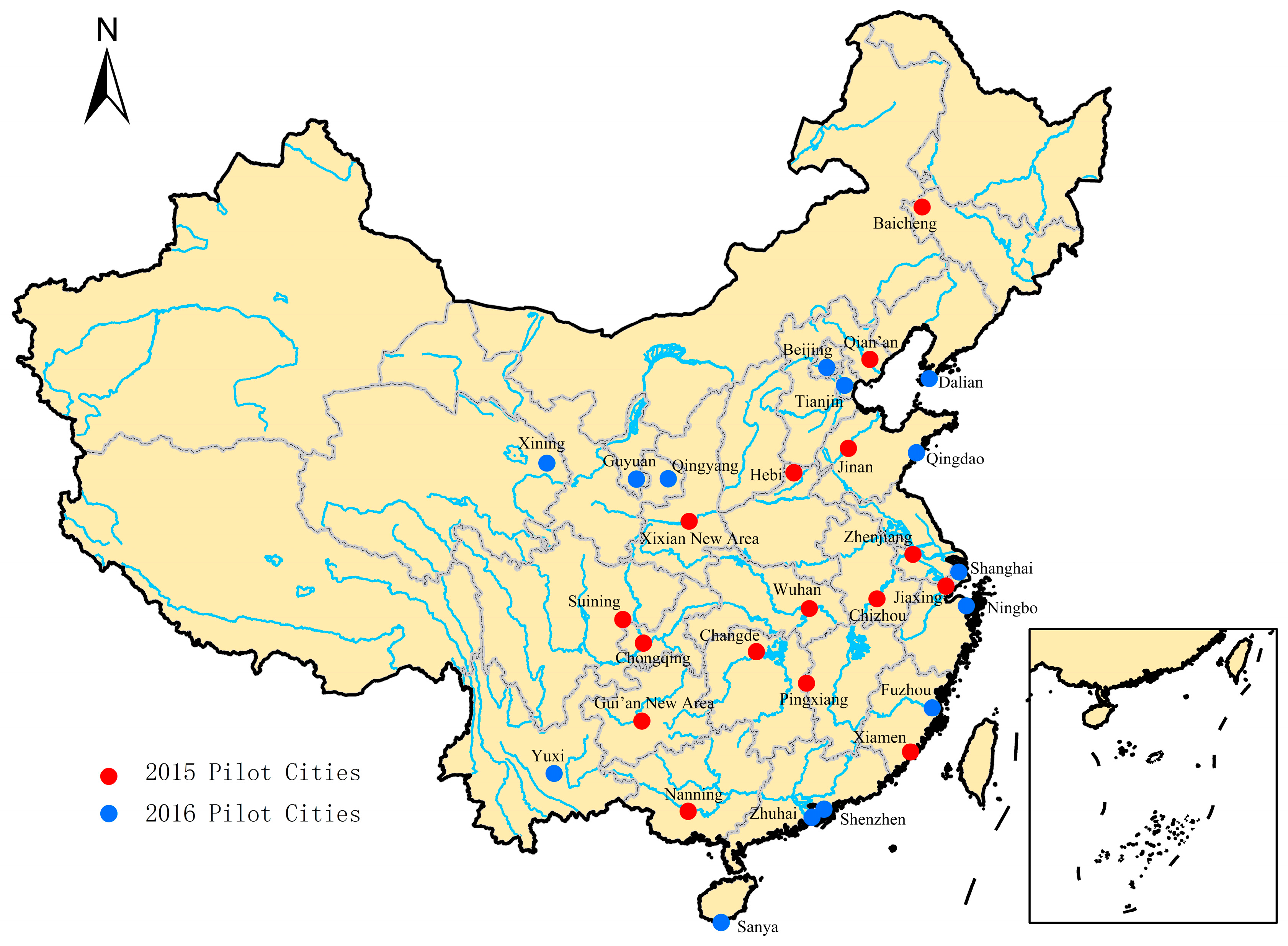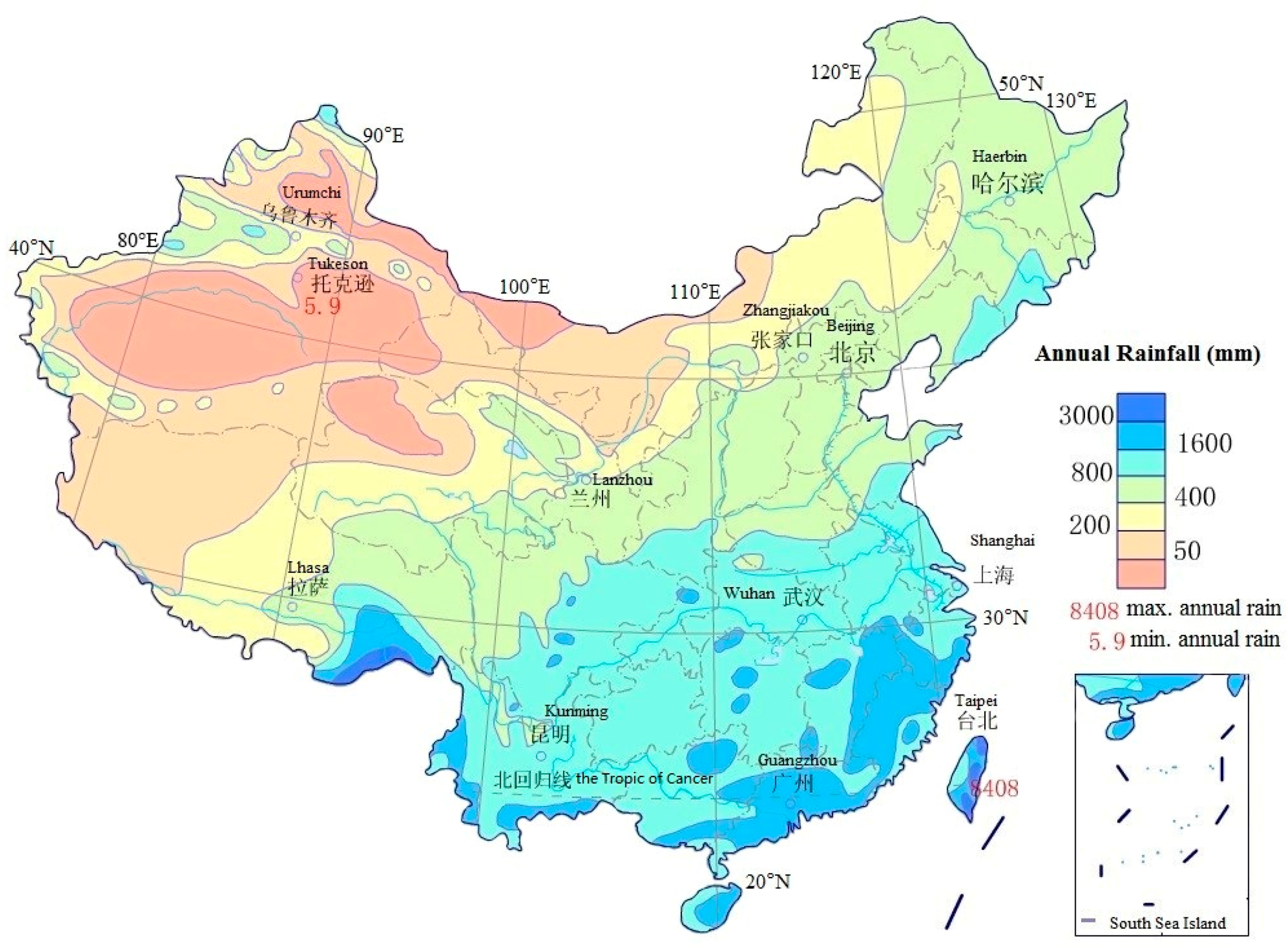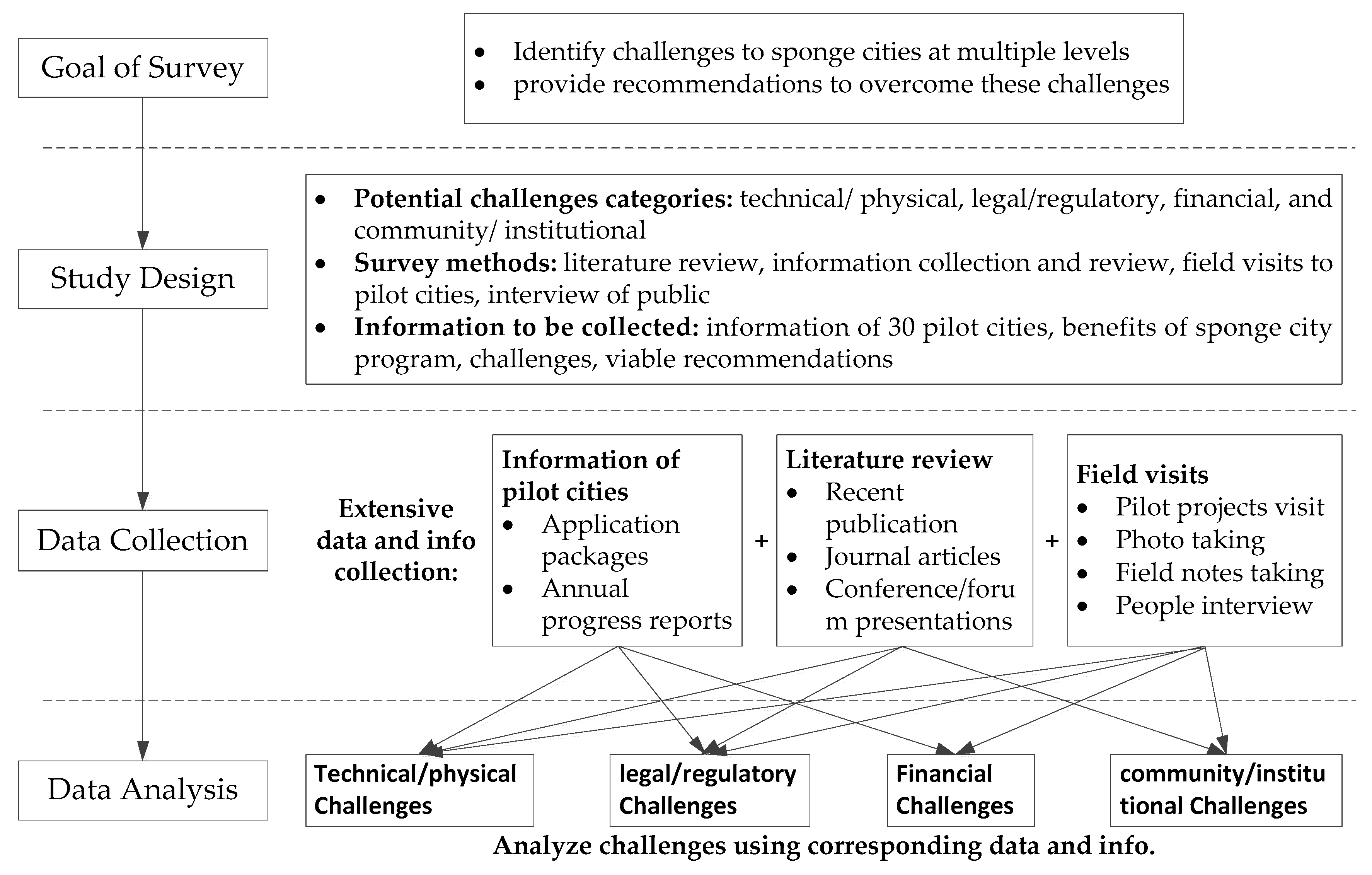Sponge City Construction in China: A Survey of the Challenges and Opportunities
Abstract
:1. Introduction
2. General Descriptions of Pilot Cities
3. Materials and Methods
3.1. Study Design
3.2. Data Collection Procetures
3.3. Data Analysis
4. Major Challenges
4.1. Technical Challenges
4.2. Physical Challenges
4.3. Financial Challenges
4.4. Legal and Regulatory Challenges
4.5. Public Acceptance Challenges
4.6. Inter-Agency Cooperation and Data Sharing Challenges
5. Future Opportunities
5.1. Taking an Integrated, Watershed Scale Approach
5.2. Enhancing Guidance and Design Standards for Local Conditions
5.3. Promoting Government Leadership and Inter-Agency Cooperation
5.4. Establishing Locally Based Legislation Framework
- (1)
- Establish decision-making processes surrounding land development activities that protect the integrity of the watershed and preserve the health of water resources.
- (2)
- Require that new developments, redevelopments and all land conversion activities maintain the natural hydrologic characteristics of the land to reduce flooding, stream bank erosion, siltation, nonpoint source pollution, property damage, and to maintain the integrity of stream channels and aquatic habitats.
- (3)
- Establish minimum post-development LID management standards and design criteria and control of stormwater runoff quantity and quality; establish minimum design criteria for the protection of groundwater resources; establish minimum design criteria for measures to minimize nonpoint source pollution from stormwater runoff.
- (4)
- Establish design and application criteria for the construction and use of structural stormwater control facilities that can be used to meet the minimum post-development LID management standards.
- (5)
- Encourage the use of LID practices such as reducing impervious cover and the preservation of green space and other natural areas to the maximum extent practicable.
- (6)
- Establish provisions for the long-term responsibility for and maintenance of sponge city facilities to ensure that they continue to function as designed and pose no threat to public safety;
- (7)
- Establish provisions to ensure that there is an adequate funding mechanism including guarantee for the proper review, inspection and long-term maintenance of the sponge city facilities implemented.
- (8)
- Establish administrative procedures and fees for the submission, review, approval or disapproval of sponge city plans, and for the inspection of approved active projects, and long-term follow up.
5.5. Finding Innovative Ways to Create More Funding Options
5.6. Continuous Research
6. Conclusions
Acknowledgments
Author Contributions
Conflicts of Interest
Appendix A
| No | Pilot Cities | General Information | Goals of Sponge City Construction | Investment (Billion-RMB) | ||||||||||||
|---|---|---|---|---|---|---|---|---|---|---|---|---|---|---|---|---|
| Water Quantity | Water Quality | Water Disaster Prevention | ||||||||||||||
| Annual Average Rainfall (mm) | Annual Average Evapor. (mm) | Temperature (°C) | Pilot Area (km2) | Existing Drainage Capacity (a) | Ex. Flood Control Capacity (a) | Average Annual Runoff Contl (%) | Rain Water Resourcing (%) | Water Quality Control SS (%) | Wastewater Recycling (%) | Drainage Standard (a) | Pluvial Flood Standard (a) | Fluvial Flood Standard (a) | ||||
| Annual Average | Average High/Low | |||||||||||||||
| 1 | Qian’an | 672 | 1100 | 11.5 | 26/−5 | 21 | 0.5–1 | 20–50 | 80 | 7 | -- | 30 | 2 | 20 | 50 | 4.493 |
| 2 | Baicheng | 410 | 1840 | 4.6 | 38/−32 | 21 | 1–3 | 10/20 | 85 | 6 | 60 | 25 | 3–5 | 20 | 50 | 4.230 |
| 3 | Zhenjiang | 1063 | 1277 | 16.1 | 29/3 | 22.0 | 2–5 | 20–50 | 75.0 | 8 | 60 | 25 | 2–5 | 30 | 100 | 3.060 |
| 4 | Jiaxing | 1194 | 1313 | 17.2 | 29/5 | 18.4 | 0.5–1 | 50 | 75.0 | -- | 40 | 25 | 2–5 | 30 | 100 | 1.948 |
| 5 | Chizhou | 1483 | 1444 | 12.7 | 24/1 | 18.5 | 1–2 | 10–20 | 80.0 | -- | -- | 20 | 2–5 | 20–30 | 50–100 | 4.045 |
| 6 | Xiamen | 1530 | 1651 | 21.3 | 29/14 | 45.5 | 2–5 | 50 | 75.0 | 5 | -- | -- | 2–5 | 50 | 50 | 6.474 |
| 7 | Pingxiang | 1600 | -- | 18.1 | 30/6 | 28.8 | 2–3 | -- | 80.0 | -- | -- | -- | 2–3 | 30 | 50 | 4.600 |
| 8 | Jinan | 665 | 1526 | 14.8 | 28/−1 | 39 | 1–5 | <100 | 75 | -- | -- | -- | 2–10 | 30–50 | 50 | 7.600 |
| 9 | Hebi | 665 | 2016 | 14.1 | 28/−1 | 29.8 | 1 | 50 | 70 | -- | -- | -- | 2–5 | 30 | 100 | 3.476 |
| 10 | Wuhan | 1257 | 950 | 17.2 | 30/4 | 38.0 | 10 | 50–100 | 75.0 | -- | 50 | -- | 5–10 | 50 | 200 | 10.278 |
| 11 | Changde | 1366 | -- | 17.5 | 29/5 | 41.2 | 2–5 | 50 | 80.0 | 8 | 75 | -- | 2–5 | 30 | 100 | 17.350 |
| 12 | Nanning | 1298 | 1367 | 22.6 | 29/14 | 60.2 | 2 | 20–50 | 75.0 | -- | 50 | 20 | 2–5 | 20 | 100 | 9.519 |
| 13 | Chongqing | 1107 | 1193 | 18.0 | 7/35 | 18.7 | 2–5 | 50–100 | 80.0 | 5 | 50 | -- | 3–5 | 50 | 100 | 7.047 |
| 14 | Suining | 928 | 950 | 17.8 | 28/7 | 25.0 | 1–3 | 20–50 | 80.0 | -- | -- | -- | 2–5 | 30 | 50 | 5.760 |
| 15 | Gui’an | 1158 | 1200 | 15.3 | 24/5 | 19.1 | -- | -- | 85.0 | 10 | 56 | -- | 2–5 | 30 | 100 | 4.760 |
| 16 | Xixian | 520 | 1481 | 14.3 | 27/1 | 17.8 | -- | -- | 80 | -- | >60 | 30 | 2–5 | 50 | 50–200 | 3.123 |
| 17 | Fuzhou | 1360 | 970 | 19.7 | 28.8/10.6 | 36.9 | 1–2 | 20 | 75.0 | 2 | 45 | 2 | 3–5 | 20–50 | 20–200 | 7.800 |
| 18 | Zhuhai | 1766 | 1469 | 23.0 | 32.2/−3 | 52.0 | 1–3 | 20–50 | 70.0 | 10 | 50 | 15 | 3–5 | 30–50 | 100 | 10.656 |
| 19 | Ningbo | 1517 | 830 | 17.2 | 29/6 | 31.0 | 1–3 | 20–100 | 80.0 | 22 | 60 | 40 | 3–10 | 50 | 100–200 | 6.042 |
| 20 | Yuxi | 909 | 1801 | 19.2 | 22/10 | 20.9 | -- | 20 | 82.0 | 10 | 50 | 20 | 3–5 | 30 | 100 | 4.873 |
| 21 | Dalian | 736 | 1551 | 9.1 | 22/−8.1 | 21.8 | 1–3 | 50 | 75.0 | 5 | 50 | 25 | >2 | 20 | 50 | 2.898 |
| 22 | Shenzhen | 1837 | 1675 | 22.4 | 29/16 | 24.9 | 1–5 | 20–50 | 70.0 | ≥8 | 60 | 30 | 3–5 | 50 | 200 | 3.529 |
| 23 | Shanghai | 1191 | 1420 | 15.7 | 29/5 | 79.0 | 2–5 | 200 | 80.0 | 8 | 80 | 20 | 5 | 100 | 200 | 8.560 |
| 24 | Qingyang | 510 | 1425 | 9.5 | 23/−8.4 | 29.6 | 1 | 20 | 90.0 | 5 | 60 | -- | 2–5 | 30 | 100 | 4.735 |
| 25 | Xining | 460 | 1364 | 6.2 | 14.9/−0.3 | 21.6 | -- | 50–100 | 88.0 | 2 | 60 | 50 | 2–5 | 50 | 100 | 6.375 |
| 26 | Sanya | 1392 | 2361 | 25.5 | 28.8/21.6 | 20.3 | -- | -- | 70.0 | 5 | -- | 20 | 2–5 | 30 | 100 | 4.040 |
| 27 | Qingdao | 776 | 1401 | 12.2 | 25.1/−1.2 | 25.2 | 2–3 | 50 | 75.0 | 8 | 65 | 30 | 2–5 | 50 | 100 | 4.870 |
| 28 | Guyuan | 458 | 1099 | 6.1 | 24.7/−14.3 | 23.0 | -- | -- | 85.0 | 10 | 40 | 30 | 2 | 30 | 50 | 3.654 |
| 29 | Tianjin | 511 | 1639 | 13.5 | 27.2/−2.4 | 39.5 | 1–3 | 50 | 80.0 | 5 | 65 | 60 | 3–5 | 20–50 | 50–200 | 7.490 |
| 30 | Beijing | 573 | 1164 | 11.7 | 26/−4.7 | 19.4 | 3–5 | 50 | 84.4 | 3 | 42 | 75 | 2–10 | 50 | 100 | 3.937 |
References
- National Bureau of Statistics of China. China Statistical Yearbook 2015; China Statistics Press: Beijing, China, 2015.
- Research Group of Control and Countermeasure of Flood (RGCCF). Control and countermeasure of flood in China. China Flood Drought Manag. 2014, 3, 46–48. [Google Scholar]
- Lv, Z.; Zhao, P. First report about urban flood in China: 170 cities unprotected and 340 cities down-to-standard. Zhongzhou Constr. 2013, 15, 56–57. [Google Scholar]
- Chen, Z.; Lu, M.; Ni, P. Urbanization and Rural Development in the People’s Republic of China; ADBI Working Paper 596; Asian Development Bank Institute: Tokyo, Japan, 2016; Available online: https://www.adb.org/publications/urbanization-and-rural-development-peoples-republic-china/ (accessed on 11 November 2016).
- Zevenbergen, C.; Veerbeek, W.; Gersonius, B.; Van Herk, S. Challenges in urban flood management: Travelling across spatial and temporal scales. J. Flood Risk Manag. 2008, 1, 81–88. [Google Scholar] [CrossRef]
- Zhou, Q.; Mikkelsen, P.S.; Halsnaes, K.; Arnbjerg-Nielsen, K. Framework for economic pluvial flood risk assessment considering climate change effects and adaptation benefits. J. Hydrol. 2012, 414–415, 539–549. [Google Scholar] [CrossRef]
- Chang, H.K.; Tan, Y.C.; Lai, J.S.; Pan, T.Y.; Liu, T.M.; Tung, C.P. Improvement of a drainage system for flood management with assessment of the potential effects of climate change. Hydrol. Sci. J. 2013, 58, 1581–1597. [Google Scholar] [CrossRef]
- Ministry of Housing and Urban-Rural Development (MHURD). Technical Guide for Sponge Cities—Water System Construction of Low Impact Development. Available online: http://www.mohurd.gov.cn/zcfg/jsbwj_0/jsbwjcsjs/201411/W020141102041225.pdf (accessed on 22 October 2016).
- United States Environmental Protection Agency (US EPA). Low-Impact Development Design Strategies: An Integrated Design Approach; EPA 841-B-00003; US EPA: Washington, DC, USA, 1999. [Google Scholar]
- Benedict, M.; Mcmahon, E. Green infrastructure: Smart conservation for the 21st century. Renew. Resour. J. 2002, 20, 12–17. [Google Scholar]
- British Columbia Ministry of Environment (BCME). Stormwater Planning: A Guidebook for British Columbia. Available online: http://www.env.gov.bc.ca/epd/mun-waste/waste-liquid/stormwater/ (accessed on 4 September 2016).
- Olewiler, N. The Value of Natural Capital in Settled Areas of Canada; Ducks Unlimited Canada and The Nature Conservancy of Canada: Toronto, ON, Canada, 2004. [Google Scholar]
- Alexander, D.; Tomalty, R. Smart growth and sustainable development: Challenges, solutions and policy directions. Local Environ. 2002, 7, 397–409. [Google Scholar] [CrossRef]
- Lehmann, S. UNESCO Chair in Sustainable Urban Development. In The Principles of Green Urbanism; Earthscan: London, UK, 2010. [Google Scholar]
- Beatly, T. Green Urbanism: Learning from European Cities; Island Press: Washington, DC, USA, 1999. [Google Scholar]
- Barthod, C.; Deshayes, M. Trame Verte et Bleue, the French Green and Blue Infrastructure. Ministère de l’Écologie, de l’Énergie du Développement durable et de l’Aménagement du Territoire. Available online: http://www.developpement-durable.gouv.fr (accessed on 3 September 2016). (In French).
- Sharma, A.K.; Pezzaniti, D.; Myers, B.; Cook, S.; Tjandraatmadja, G.; Chacko, P.; Chavoshi, S.; Kemp, D.; Leonard, R.; Koth, B.; et al. Water Sensitive Urban Design: An Investigation of Current Systems, Implementation Drivers, Community Perceptions and Potential to Supplement Urban Water Services. Water 2016, 8, 272. [Google Scholar] [CrossRef]
- Jenkins, S. Towards Regenerative Development. Available online: www.planning.nz (accessed on 10 September 2016).
- General Office of the State Council (GOSC). Guideline to Promote Building Sponge Cities. Available online: http://www.gov.cn/zhengce/content/2015-10/16/content_10228.htm (accessed on 16 October 2015).
- Ministry of Finance of the People’s Republic of China (MOF). Notice on the Implementation of the Central Financial Support to the Construction of Pilot Sponge Cities. 2014. Available online: http://jjs.mof.gov.cn/zhengwuxinxi/tongzhigonggao/201501/t20150115_1180280.html (accessed on 31 December 2014).
- Office of State Flood Control and Drought Relief Headquarters; Disaster Reduction Committee of Chinese Hydraulic Engineering Society. China Urban Flood Control; China Water & Power Press: Beijing, China, 2008. [Google Scholar]
- China National Knowledge Infrastructure (CNKI). Available online: http://nvsm.cnki.net/KNS/ (accessed on 10 February 2017).
- WANFANG DATA (WANFANG). Available online: http://www.wanfangdata.com/ (accessed on 13 February 2017).
- Chinese Science Citation Database (CSCD). Available online: http://sciencechina.cn/search_sou.jsp (accessed on 6 February 2017).
- VIP JOURNAL INTEGRATION PLATFORM (VIP). Available online: http://lib.cqvip.com/ (accessed on 20 February 2017).
- Wu, C.; Li, Z. The current situation and future trend of urban rain water harvesting. Water Wastewater Eng. 2002, 28, 12–14. [Google Scholar]
- Wang, H.; Cheng, X.; Li, C. Quantitative Analysis of Stormwater Management Strategies in the Process of Watershed Urbanization. J. Hydraul. Eng. 2015, 46, 19–27. [Google Scholar]
- Wang, H.; Li, C.; Li, N.; Yu, Q. Green infrastructure design principles and integration of gray and green infrastructures. Water Wastewater Eng. 2016, 42, 51–56. [Google Scholar]
- Wang, H.; Li, C.; Zhang, W.; Jiang, X. Framework for the planning of urban stormwater infrastructures. Urban Plan. Int. 2015, 30, 72–77. [Google Scholar]
- Wang, H.; Ding, L.; Cheng, X.; Li, N. Hydrologic control criteria framework in the United States and its referential significance to China. J. Hydraul. 2015, 46, 1261–1271. [Google Scholar]




| Technical: |
| ● Design and construction codes and standards |
| ● Performance and sustainability of sponge city measures |
| ● Technology and materials |
| ● Monitoring techniques and standards |
| ● Education and training |
| ● Operation and maintenance |
| Legal: |
| ● Local, provincial and national rules, ordinance, policies, regulations, laws and guidelines |
| ● Municipal structure for maintenance and ownership |
| ● Opportunities |
| Financial: |
| ● Full life cycle and maintenance costs of sponge city measures |
| ● Social, economic and environmental benefits of sponge city measures |
| ● Financial sources |
| ● Private sector’s interests |
| ● Incentives |
| Community/Institutional: |
| ● Public knowledge, interests, and involvement of sponge city construction |
| ● Community education |
| ● Aesthetics |
| ● Cooperation between agencies and communities |
| ● Available information |
| Data | Qian’an | Baicheng | Shenzhen | Yuxi |
|---|---|---|---|---|
| Annual Temp. (°C) | 11.5 | 4.6 | 22.4 | 19.2 |
| Annual Rainfall (mm) | 672 | 410 | 1837 | 909 |
| Annual Evap. (mm) | 1100 | 1840 | 1675 | 1801 |
| Runoff Control (%) | 80 | 85 | 70 | 82 |
| Runoff Control (mm) | 28.0 | 25 | 31.3 | 23.9 |
| Rain Resourcing (%) | 7 | 6 | ≥8 | 10 |
| Green Roof (%) | 6 | 5 | ≥30 | 12.6 |
| Depressed Green (%) | 35 | 36.4 | ≥10 | 35.4 |
| Permeable Paver (%) | 46.5 | 46.2 | ≥70 | 38.2 |
| Products | AVLB | LMTD | UNAV | Remarks |
|---|---|---|---|---|
| Cistern/Rain Barrel | √ | Simple small-size above ground barrels available without control apparatus | ||
| Rain Garden System | √ | |||
| Tree Planter System | √ | |||
| Green/Blue Roof System | √ | Include green and blue roof modular | ||
| Infiltration Planter System | √ | |||
| Pervious Pavement | √ | Various products available, but quality and durability are uncertain | ||
| Underground Infiltration | √ | |||
| Underground Detention | √ | Very limited small-scale, small-sized products available. | ||
| Water Quality Control | √ | refers to vortex flow control device, inlet filter device, etc. | ||
| Monitoring Equipment | √ | Mostly copy versions of international products, and generally in poor quality and poor accuracy |
© 2017 by the authors. Licensee MDPI, Basel, Switzerland. This article is an open access article distributed under the terms and conditions of the Creative Commons Attribution (CC BY) license (http://creativecommons.org/licenses/by/4.0/).
Share and Cite
Li, H.; Ding, L.; Ren, M.; Li, C.; Wang, H. Sponge City Construction in China: A Survey of the Challenges and Opportunities. Water 2017, 9, 594. https://doi.org/10.3390/w9090594
Li H, Ding L, Ren M, Li C, Wang H. Sponge City Construction in China: A Survey of the Challenges and Opportunities. Water. 2017; 9(9):594. https://doi.org/10.3390/w9090594
Chicago/Turabian StyleLi, Hui, Liuqian Ding, Minglei Ren, Changzhi Li, and Hong Wang. 2017. "Sponge City Construction in China: A Survey of the Challenges and Opportunities" Water 9, no. 9: 594. https://doi.org/10.3390/w9090594
APA StyleLi, H., Ding, L., Ren, M., Li, C., & Wang, H. (2017). Sponge City Construction in China: A Survey of the Challenges and Opportunities. Water, 9(9), 594. https://doi.org/10.3390/w9090594





